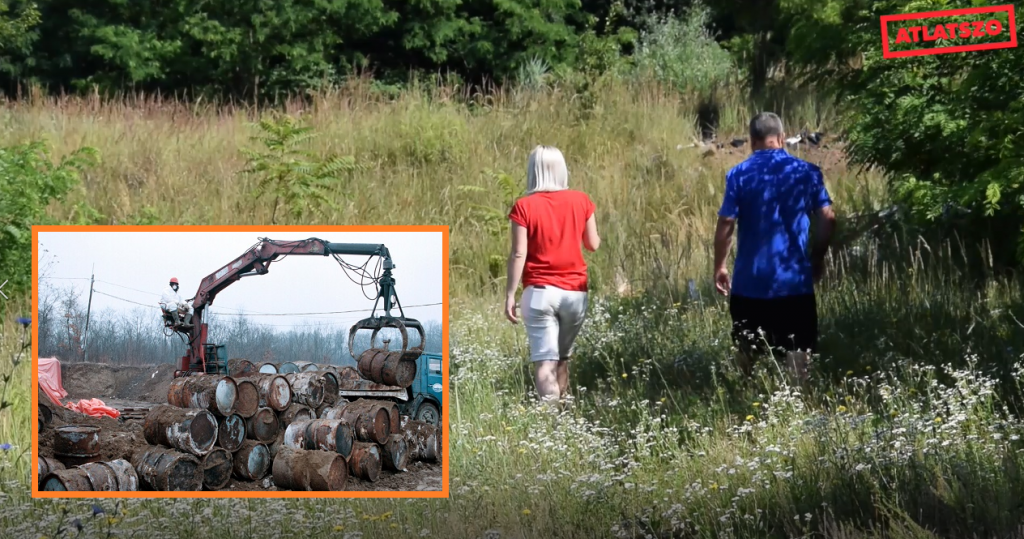The https://english.atlatszo.hu use cookies to track and profile customers such as action tags and pixel tracking on our website to assist our marketing. On our website we use technical, analytical, marketing and preference cookies. These are necessary for our site to work properly and to give us inforamation about how our site is used. See Cookies Policy
Carcinogenic soil and groundwater contamination at hazardous levels in Hidas and Garé
Now bankrupt chemical manufacturer company Budapesti Vegyiművek (Budapest Chemical Works, BCW) has been producing and packaging pesticides and insecticides since the 1960s in Hidas, Baranya County. Chlorobenzene derivatives were generated as a waste by-product from the manufacturing process, the hazardous waste was stored in 200-liter metal barrels near the factory. The barrels corroded and toxic material leaked into the ground, contaminating soil and groundwater on site.
Tens of thousands of barrels containing the hazardous waste were later taken from Hidas to a temporary hazardous waste storage unit at the outskirts of another small Baranya County village, Garé. In eight years, 16,000 tons of hazardous chemical waste was transported to the Garé dump site, where the metallic drums were simply buried in the ground. By 1988 the carcinogenic pollutants could be detected in nearby monitoring wells, groundwater, vegetation and air – even over longer distances.
Hungarian authorities first obliged BCW to eliminate the environmental damage in 1988, when locals started to complain on the constant smell of chemicals, and tetrachlorobenzene was detected in dead cattle. Cleaning up the landfill lasted until 2002 – the state intervened, corroded barrels were dug up, repackaged and sent to chemical waste incinerators, costing billions of forints to the hungarian taxpayers.
However, BCW went bankrupt in 2007, and damage control stopped altogether both in Hidas and Garé, leaving the groundwater and thousands of tons of soil heavily contaminated on both sites. In 2015 Greenpeace asked the Baranya County Government Office for official data on the contamination levels, but the state did not release the data until Greenpeace sued them in court and won the case in 2019.
Official measurements finally released show strikingly high levels of chlorobenzenes on both sites in groundwater and soil, exceeding the legal contamination limit by 1200-28000 times.
The chemicals detected in 2015 (PDF) are carcinogenic, irritate the skin, eyes, respiratory system and damage the liver. Garé mayor Imre Vig complained about mysterious cancer death cases to Atlatszo reporters, including a 27 years old mother deceased due to liver cancer.
A vadhúsnak is vegyszerszaga van, a talajvízben terjed a halálos méreg Garén from atlatszo.hu on Vimeo.
According to Dr. István Kenessey of the National Cancer Registry and Biostatistics Center, in the larger area of Hidas and Garé the number of new cancer cases is significantly higher than the national average. During the period 2011-2015, 1497 (4.31%) people were diagnosed with primary malignant tumors in Siklós district (Garé) and 513 (4.59%) in Pécsvárad district (Hidas), while the national frequency was 3.97 percent.
In addition, Atlatszo discovered that in Hidas wheat and sunflower is grown on land registered for permanent environmental damage due to chlorobenzene contamination, while corn is grown alongside the Garé hazardous waste storage site, despite the groundwater being heavily polluted in both areas. Our research concluded that no state organisation is monitoring the carcinogen levels in food grown on these sites.
According to statements given, the Ministry of Agriculture expects the now bankrupt and defunct BCW to carry on with damage control, which is clearly not happening at all, despite BCW being liquidated by the state-owned liquidator company National Reorganization Nonprofit Ltd.
The Baranya County Government Office, the Ministry of Agriculture, and the National Reorganization Nonprofit Ltd. all declined to answer our questions, or comment on the situation in Hidas and Garé.
Written and translated by Eszter Katus
You can read the original, Hungarian language stories here and here.





